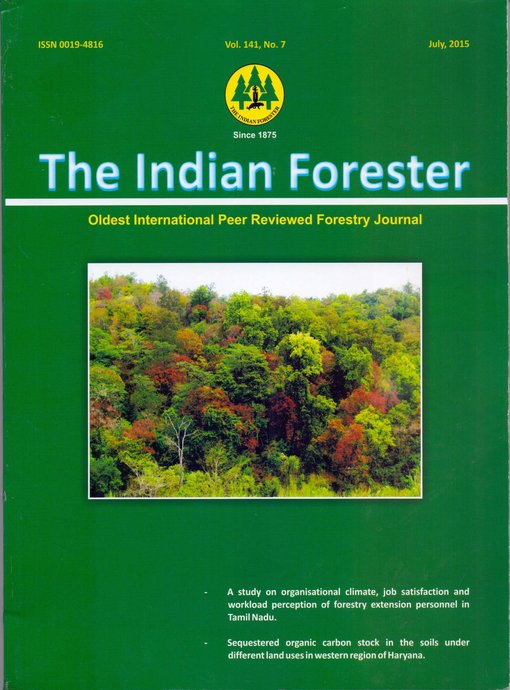Studies on the Effect of Pre-Sowing Treatments on Germination Behaviour of Ribes alpestre Wall. Ex Decne Seeds.
DOI:
https://doi.org/10.36808/if/2015/v141i7/73873Keywords:
Seed, Ribes alpestre, Germination Behaviour, Presowing Treatment.Abstract
Asian gooseberry (Ribes alpestre) is an important wild edible shrub of dry temperate and cold desert region of Western Himalaya. An experimental trial was conducted to study the effect of different pre-sowing treatments on seed germination of R. alpestre under laboratory condition. The ripened berries were collected from the naturally growing shrubs and seeds were extracted from the berries, dried and sown in petridishes in seed germinator after giving presowing treatments. It was found that seeds treated with conc. H2SO4 for 2 minutes (T6) recorded maximum 69.33 percent germination followed by 64.66 percent germination in seed treated with conc. H2SO4 for 1 minute (T5) where as untreated seeds (control) recorded minimum 39.00 per cent germination. Therefore, it is recommended that the seed of R. alpestre should be treated with conc. H2SO4 for 2 minutes followed by 24 hours soak in cold water before sowing in the nursery for breaking seed dormancy and getting maximum germination.References
Anon. (1972). The Wealth of India, Raw Materials, IX: Rh-So. Publication and Information Directorate, CSIR, New Delhi. pp25.
Bewley J.D. and Black M. (1985). Seeds: Physiology of development and germination. Plenum Press, New York, USA. 367p.
Bhagat S. and Singh V. (1995). Studies on effect of concentrated sulphuric acid treatment on germination of Rubus ellipticus seed. Indian Forester,121 (7): 643-646.
Bimlendra K. and Toky O.P. (1993). Breaking of seed coat dormancy with acids in some arid zone trees. Journal of Tree Sciences, 12(2): 111-114.
Bisht P.S. and Kediyal V.K. (1995). Effect of chemical treatments on germination and survival of the seedlings in Atropa belladonna Linn. Indian Journal of Forestry, 18(3): 208-210.
Chacko K.C. and Pillai P.K.C. (1997). Effect of pre-treatments on germination of Asparagus racemosus seeds.Journal of NonTimber Forest Products, 4(1/2):23-25.
Cooper P. (1986). Lignum vitae (Guaiacum officinale) seed pretreatment experiment. For. Dept., Grenada. 7p. For. Abstr., 50:560.
Czabator F.J. (1962). Germination Value: an index combining speed and completeness of Pine seed germination. Forest Science, 8: 386 - 396.
Delouche J.C. (1964). Seed Dormancy: A General Discussion. Seed Technology Lab., Mississippi State Univ., Mississippi, 12p.
ISTA (1976). International Rules for Seed Testing. Rules and Annexes. International Seed Testing Association. Seed Science and Technology, 4: 3-177.
ISTA (1985). International Rules for Seed Testing. Seed Science and Technology, 13: 322-341.
Jerlin R. and Vadivelu K.K. (1994). Standardization of presowing treatments for Acacia mellifera (Vahl.) Benth. seeds. Indian Journal of Forestry, 17(4): 284-287.
Kapoor K.S., Jishtu V., Negi P.S., Subramani S.P. and Rawat R.S. (2001). Cold Desert Afforestation and Pasture Establishment, A status report prepared under World Bank Aided FREE Project, 182p.
Khasa P.D. (1992). Scarification of Limba seeds with hot water, bleach and acid. U. S. Forest Service. Tree Planter Notes, 43: 150-152.
Kumar D. (1990). Maturity indices and pretreatment studies on the seeds of Celtis australis Linn. M. Sc. Thesis, Dr. Y. S. Parmar University of Horticulture and Forestry, Solan, India. 87p.
Snedecor G.W. and Cochran W.G. (1967). Statistical Methods, 6th edition, Oxford and IBH Publishing Co., New Delhi. 569-571.
Sharma S. (1997). Studies on seed quality parameters of important social forestry tree species. Ph. D. Thesis, Dr. Y.S. Parmar, University of Horticulture and Forestry, Solan, India. 193p.
Sharma S., Kumar S., Thakur K.S. and Negi P.S. (2005). Study on the effect of presowing treatments on germination of Ribes orientale Desf. seeds. Indian Forester, 131(5): 667-672.
Downloads
Downloads
Published
How to Cite
Issue
Section
License
Unless otherwise stated, copyright or similar rights in all materials presented on the site, including graphical images, are owned by Indian Forester.





